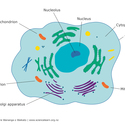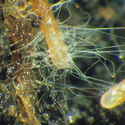It doesn’t breathe, it doesn’t eat, it doesn’t excrete, and it doesn’t grow – so it can’t be alive, can it? It hijacks a living cell1 and uses it to produce so many copies of itself that it bursts the cell – so it can’t be dead, can it?
What is it? A virus2.
Viruses come in many shapes and sizes and infect every living thing.
Viruses are very, very small – about one 500th the size of a single skin cell. Comparing a virus to the size of a flea is like comparing a person to the size of Mt Everest. If a skin cell was the size of an A4 page, a virus would be the size of a 10 cent piece.
Viruses are very simple, with a relatively short piece of genetic code3 inside a packaging of protein4 called a capsid. When the virus infects a cell, it inserts its genetic5 code into the cell and takes over the machinery of the host cell6 to make lots of copies of its genetic code and proteins for its capsid. The new viruses are then assembled inside the host7 cell and eventually burst the cell and kill it. Viral destruction of cells causes disease8.
Different viruses infect different types of cells, which is why each causes its own unique disease. For example, HIV9 (the AIDS10 virus) infects immune cells11, which is why patients with the HIV virus are unable to resist other infections12 and cancers. The cold virus infects the cells in the back of your nose and throat, which is why you get a sore throat, sneeze a lot and get a runny nose.
There are even a whole group of viruses that infect bacteria13 called bacteriophage. The term virus comes from the Latin for poison14.
Grouping viruses
Viruses are grouped according to the type of genetic code they carry – either DNA15 or RNA16 – and then by the shape of their capsid. The diagrams above shows the relative size and appearance of some virus families. The family17 name has been given as well as one of the human diseases18 caused by a virus from that family.
A virus is a simple structure yet it can be deadly. Viruses replicate19 quickly and can go undetected by our immune systems due to mutation20 or reassortment. This leads to new virus strains. Explore this further in the article Virus strains.
Nature of Science
Scientists are discovering how viruses affect cells, but this changes with time as the viruses mutate21. Often, scientific knowledge is tentative22 or based on our knowledge at the time the observations were made.
Activity ideas
Exploring microorganisms asks students to research and summarise the key features of bacteria, viruses and fungi23.
Make an adenovirus uses a template to make a model of an adenovirus and asks students to investigate the different shapes of different viral diseases and the similarities and differences between viral families.
Spreading diseases demonstrates how a viral disease can spread through a population24, even if an individual only comes in contact with three other people.
This article is about coronaviruses, a group of viruses that cause upper respiratory illnesses in humans. In 2020, the COVID-19 virus caused a global pandemic25.
Collection
We have curated content in this Viruses and the immune system collection – it explores viruses and how our immune system26 fights them. Log in to make this collections part of your private collection. Click on the copy icon, and then you can add additional content and notes and make other changes.
Useful links
In this Science on a Napkin video Hannah Brightley interviews Dr Heather Hendrickson (Massey University) to learn more about bacteriaphages and how they could be used to help fight honeybee disease American FoulBrood (AFB).
In this Radio NZ Our Changing World programme Investigating the virosphere discover the work being undertaken on a range of native27 New Zealand species28 to find out what viruses are associated with them. The goal is to build on our knowledge of virus diversity and to help us figure out how viruses jump to new hosts.
- cell: 1. Building block of the body. A human is made of millions of cells, which are adapted for different functions and can reproduce themselves exactly. 2. A simple electrolytic device that enables chemical energy to be transformed into electrical energy.
- virus: A microscopic infectious particle that can only multiply inside the cells of living organisms. They are capable of taking over the cell to produce copies of itself. They are inactive outside of a living host cell.
- genetic code: The DNA sequence of a particular organism.
- protein: Any of a large class of complex compounds that are essential for life. Proteins play a central role in biological processes and form the basis of living tissues. They have distinct and varied three-dimensional structures. Enzymes, antibodies and haemoglobin are examples of proteins.
- genetic: Of, relating to, or determined by genes.
- host cell: A living cell in which a virus reproduces.
- host: An organism that contains a parasite or other dependent organism. Hosts usually provide the dependent organism with food and shelter.
- diseases: 1. An abnormal condition of an organism that impairs bodily functions. 2. In plants, an abnormal condition that interferes with vital physiological processes.
- HIV: The virus that causes acquired immune deficiency syndrome (AIDS). This virus causes the immune system to fail and gives opportunities for life-threatening infections to become established in the body.
- acquired immune deficiency syndrome (AIDS): A disease that destroys the body’s ability to fight infection. It is caused by the human immunodeficiency virus (HIV).
- immune cells: Cells that circulate in the blood that help fight off or prevent disease.
- infection: Invasion of the body or a species by something that could be harmful or cause a disease.
- bacteria: (Singular: bacterium) Single-celled microorganisms that have no nucleus.
- poison: A substance that, through its chemical action, usually kills, injures or impairs an organism.
- DNA: Deoxyribonucleic acid (DNA) is a molecule that contains the instructions needed for an organism to develop and function. These instructions are stored as a code made up of four chemical bases: adenine (A), guanine (G), cytosine (C) and thymine (T).
- RNA: A molecule generated in cells by transcription and required for the synthesis of proteins. RNA (Ribonucleic acid) is made up of a large number of nucleotides to form a long single strand. A chemical code for genetic information.
- family: A classification grouping that ranks above genus and below order (kingdom > phylum > class > order > family > genus > species).
- diseases: 1. An abnormal condition of an organism that impairs bodily functions. 2. In plants, an abnormal condition that interferes with vital physiological processes.
- replicate: Make an exact copy of.
- mutation: Occurs when the DNA is damaged or changed in such a way that it alters the genetic message carried by that gene.
- mutate: To change or alter.
- tentative: Not certain or fixed.
- fungi: The Fungi are a kingdom separate from plants and animals. Like animals, a fungus (or fungi – plural) is an organism that cannot make its own food. It can be multicellular such as mushrooms and moulds, or unicellular such as yeasts. Fungi may be decomposers, parasites, or mutualists (helping plants to grow).
- population: In biology, a population is a group of organisms of a species that live in the same place at a same time and that can interbreed.
- pandemic: A global outbreak of disease.
- immune system: The natural defence system found in living things. In humans, a network of organs, cells and proteins that helps to protect us against anything it recognises as being an ‘invader’ or ‘foreign’, for example, bacteria, viruses, cancer cells, parasites and transplanted organs and tissues. In plants, a network of disease resistance genes enable plants to detect and resist things like fungi, bacteria, viruses, nematodes and insects.
- native: A species that lives naturally in a country, as opposed to species that have been introduced by the activity of humans.
- species: (Abbreviation sp. or spp.) A division used in the Linnean system of classification or taxonomy. A group of living organisms that can interbreed to produce viable offspring.








